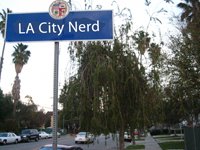 Yesterday, Palm Sunday was celebrated by most Christians in the City. The Cathedral had their service where they pass out palms to all attendees (the leftovers, of course, are burned to make the ashes for Ash Wednesday next liturgical season). Some people weave the palm into a little cross and some make intricate art from the palm fronds.
Yesterday, Palm Sunday was celebrated by most Christians in the City. The Cathedral had their service where they pass out palms to all attendees (the leftovers, of course, are burned to make the ashes for Ash Wednesday next liturgical season). Some people weave the palm into a little cross and some make intricate art from the palm fronds.But in L.A., Palm Sunday could mean more. Almost every corner of the City has treelined streets - and not just those from the opening scene of The Beverly Hillbillies, but from Watts to Sherman Oaks and Santa Monica to Boyle Heights.
Then, there is the community of Palms - they could make this a big annual event the week before Easter each year!
 Finally, and I think most notable, Palm Sunday in L.A.
Finally, and I think most notable, Palm Sunday in L.A. Additionally, Elysian park is home to one of the oldest palm tree-lined City streets: The Avenue of the Palms. According to www.historicechopark.org, in 1895 rare specimens of wild date were planted on what is now Stadium Way north of Scott Avenue. This grand entrance to the park was lauded as the gateway to the San Fernando Valley via Griffith Park, and a road was build form this point to the Los Angeles River along which to Griffith Park and beyond in 1897 (Riverside Drive?).
A recent article by Lili Singer gives a 2005 perspective of Elysian Park.


No comments:
Post a Comment